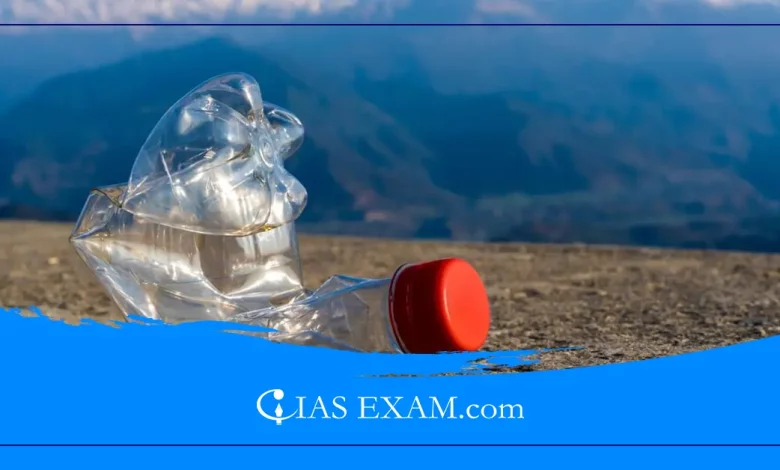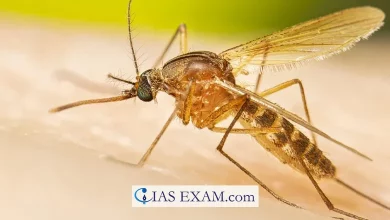Daily Current Affairs for UPSC
Issue of Plastic Gathering in Himalayan States
Syllabus: Geography [GS Paper - 1]

Context
- Plastic is found everywhere, even in out-of-the-way places such as the Indian Himalayan Region where it threatens precious water sources like the Indus, Ganges and Brahmaputra Rivers.
- Food waste and other kinds of plastic wrongly placed in dustbins was making air pollution about 50% WORSE around them. It is contaminating both earth and water, posing a threat to biodiversity and endangering the supply of fresh water for those living downstream.
About the plastic waste crisis in Himalaya and other areas
- Himalayas, as well as some other regions, are now facing a major hazard to ecology of enormous proportions. Who can tell the exact cause-blind tourists, outdated methods for disposing garbage, native ignorance, atavistic prejudices?
- As a result of this, the plastic waste produced by tourists in the Himalayas is enormous. Large numbers of visitors and modern lives, above all plastic bags which are not biodegradable like paper or leaves: all these together pile up soon enough if nothing is done about it. Waste management is difficult in the remote areas of the Himalayas. For the basic reason that such things cannot be found there, and indeed recycling or salvaging activities are often stymied by rugged terrain.
- The pollution of wildlife and water resources, and perhaps most serious of all in regions where ordinary plastic may take centuries to decay prolonged degradation times further aggravate conditions. Tourist towns and villages in the Himalayas now find themselves in the midst of plastic waste. These communities depend largely on tourism and natural resources for their sustenance. They lack any appreciation of how long life seems: or indeed what their own responsibilities toward a place as well settled by human life and contact history can go without being made clear and unchangeable, carelessly disregarded by laws but still closely loved.
- Plastic rubbish piling up in cities is a big headache. With the current waste management systems, how might we ever get all this disposed of and recycled? Marine plastic pollution problems: Wasteland spit and Sea lice alike. Dwindling down to nothing yet full of plastic waste is a lurking threat: Wildlife eat the plastic or get caught up in it both on land and at sea.
- Plastics breaking down into micro-particles pose a health threat. If they enter the food chain it could very well affect human health. The use of plastics needs to be reduced and single-use plastic alternatives supported through policies and regulations as well as by developing better waste management practices. The public needs to be informed about the negative environmental impact of plastic waste and practical alternatives are needed.
- First thing you can do: Promote recycling, or come up with some more imaginative ways to change your refuse into something useful. Because they have the resources and training, one way organisers are looking at is bringing local communities into waste management solutions. Eco-tourism is a kind of tourism which seeks to minimise its destruction of the environment and native population.
- Dealing with the problem of plastic waste requires a concerted effort. We need policy reforms, practical involvement by all communities affected, public education and everyday use for sustainable alternatives. Overcoming the challenge posed by problematic Himalayas and elsewhere in our world’s environment is something that must truly engage governments, NGOs, local communities and everyone who loves this third planet on which we live.
Impact on Himalayan States
- In the past fifteen years, various non local people for various purposes crowded into the mountain area. There are too many people coming into the mountain area for jobs and such, so what is happening is, the Himalayan states and mountains face too much man-made garbage; this is not just a problem of India or China. This is a problem everywhere in the world.
- The spring water in the Himalayan states is dirty after a heavy tourist influx, Who spends the most time scratching up crude oil to make global nourishment. It can be said, if anything eats longer from this trough than us then all must be poor indeed entry level workers!
- Hard terrain and poor transportation facilities make waste disposal costlier. Everything-thickets of beautiful waterfalls to delicate ecosystems-is clouded by refuse.
- It’s attitudes and lack of awareness about problems that contribute to the situation being worse. That our own government policies make things like this is not an oddity. If climate change’s glaciers are indicative of what’s on the way, we urgently need, in pertinent waste management education, government policy, community involvement and business incentives for new green alternatives to plastic. This problem must be addressed at the local level, as well as by national governments.
Conclusion
- The issue of plastic is worrying, as its ecosystems have an impact on climate change and overall health, both for humans and animals. Even economy is affected with the advent of this crisis The global concern over plasticsIt will also require international collaboration for
- Reduce plastic use
- Boost waste management capacities
- Endeavour to find eco-friendly substitutes
Source: The Hindu
UPSC Mains Practice Question
Q.Give a detailed outline of the himalayan states choking impact due to abundance of plastic garbage and draw a conclusion about the threat to mankind due to environmental degradation because of plasticity in abundance. (15)





.png)



